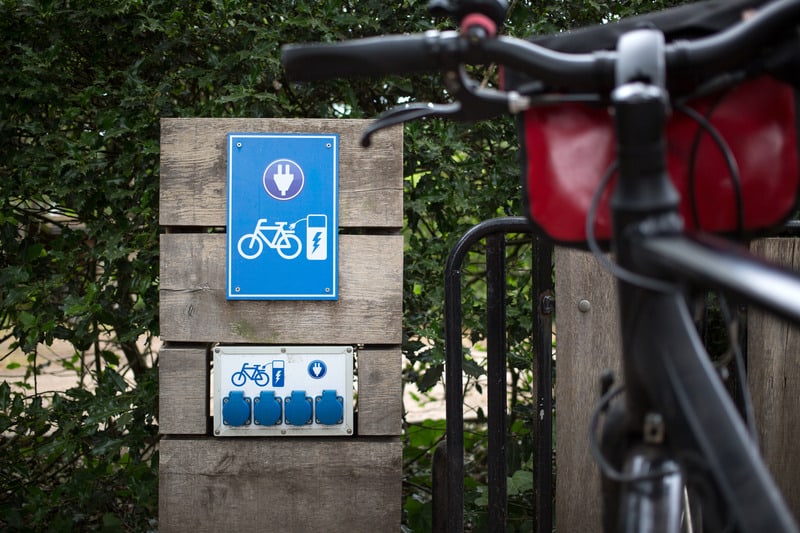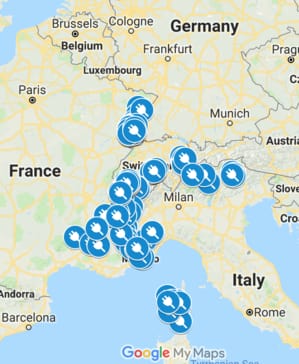Electric bikes often won’t have the largest battery on the market and range anxiety can be on your mind on longer rides and touring. Range anxiety can take a bit of the fun out of a trip around town or on holiday, but there are options that can help make sure you have enough juice to make it there and back again. With a little planning, a day out on your electric bike can be a relaxing, stress free, and enjoyable affair, without worrying if the battery will die and you’ll be stuck pedaling (or walking) a heavy bike home!
Whether you know you’ll run down the battery or for
Beyond bringing a charger along, there are a few other less common options for charging your ebike on-the-go including purpose built ebike charging stations, regenerative braking, solar panel charging, and using a car to charge your battery.
Although your ebike will typically have enough charge to get you through your daily ride, if you sized the battery to your typical needs, there are lots of reasons you may need to charge your bike while on the go:
Long touring trip where the range of your battery won’t take you the distance you need- Camping or traveling with your
ebike , away from your typical charging spots - Packing in a number of trips or errands around town,
- Commuting longer distance or towing heavier loads than usual
Plugging In On-The-Go
Top Spots Where you can plug in (with permission)
- Bike shops
- Restaurants
- Coffee Shops
- Campgrounds
- Libraries
- Picnic pavilions in parks
- Highway Works Yards
- Fire Stations
How to charge your lithium-ion ebike battery
When charging on the go, you’ll need to balance two things: how fast you can or should charge your battery and prolonging the life of your battery. Replacing a worn out battery can be expensive so taking care of it by avoiding charging too fast or overcharging it will help prolong the life of a battery pack.
Best practice for prolonging the life of your battery includes keeping your battery cool when in use and when charging and charging slow when you can. However, when you’re on the go or in need of a battery top-up, charging slow may not be very practical. Your ability to charge fast or slow will mainly come down to the type of charger you have with you.
Full Featured Chargers – these types of chargers allow you to change the amps of the charger, increasing or decreasing the charging time. Some of these units even allow changing the voltage, so that different battery types can be charged with the same charger – just be careful to match the voltage setting of the charger with the battery! Two examples of these chargers would be the Cycle Satiator (by Grin Technologies, Amazon link) or the Luna Advanced Chargers. These chargers tend to be more expensive and heavier than fixed rate chargers (below) but do come with more features (as the title suggests).
Fixed Rate Chargers – these come in a variety of Amp ratings but are usually less than 3 Amps. The higher the Amp rating, the faster the charge. These types of chargers don’t offer the flexibility or features of the “full featured” models, but are generally lighter and cheaper, both good qualities when using for an on the go charger.
How long will you need to charge
Charging time will depend on a few factors:
- Size of your battery (Ah)
- Amp rating of your charger
- How much further do you need to travel
- What is the terrain/conditions like (flat, hilly, very steep or towing heavy load)
I’ve put together this calculator that will estimate how long you’ll need to charge your battery based on type of charger (amps) and the distance you need to travel (km, working on an equivalent version for miles). Keep in mind this calculation is basic (Time = Ah / A) and does not account for fully topping up the battery, which takes more time at the end of a full charging cycle to balance the cells, but will give you an idea of charging time.
A few Other Charging Options…
Ebike charging Stations

If you are riding in an area with Ebike charging stations, then you should easily be able to charge on the go if you plan your route accordingly. You could extend the distance of an ebike tour by riding near the maximum range of your electric bike, charging midday while having a bite to eat, seeing the sites, or having a rest, and continue back home or to an overnight destination. Ebike charging stations are becoming more popular in some parts of the world and offer a few unique details to charging.
- You may need to pay for this charge
- Rate of charge could be higher, allowing for faster charge but also can be harder on your battery
- Typically have multiple charging connectors for popular or standard battery types
Where can you find them
Electric Bike charging stations seem to be much more popular in Europe, which could have to do with the greater popularity and density of electric bikes over North America. If you happen to ride a Bosch ebike, there are a number of charging stations at major tourist areas in Europe set up by Bosch.
Another company, Bike Energy, has set up a number of charging stations around Europe. You’ll need a specific adapter cable to connect your make/model of ebike battery with their network of charging stations.
There are several options for finding a charging station in North America. I’ve found most websites or apps cater to EV vehicles, but Plug Share has a number of options to narrow down the plug type to 110v wall outlet suitable for most electric bike chargers in North America.
Charging your bike while pedaling or braking
With the right type of motor (direct drive hub motor) and under the right conditions, it is possible to charge your battery through regenerative braking while you ride. The amount of regenerative braking can vary widely depending on the type of terrain you’re riding in. If you would generally need to brake more in the terrain your riding in, then there is a higher potential for generating power on the way down hills.
Generally, if you have a direct drive hub motor, with the right controller to utilize regenerative braking, you could expect between 6-10% regen for your battery in typical city riding conditions.
Solar Powered Charging
Charging your ebike with a portable solar panel can be done and might be useful in a pinch. For instance you could use this approach when biking long distances to increase range, or if biking in a remote area without a power source. However, there are several drawbacks to a solar power setup and it probably won’t be viable solution for most people. Major drawbacks include:
- Expensive components
- Typically an Inefficient process DC -> AC -> DC power conversion
- Slower charging time (dependent on the sun and favorable weather)
- Heavy components
- Need a large solar panel(s) to get charging times down
For some additional info on charging by solar panels, check out these examples of some people that put together a solar charging kit:
- How to make a solar powered electric bike
- Backup solar panel set-up for bike touring (video)
- World race solar powered bike setup
- Marissa Muller – cross country 250w solar power setup
Using a car to charge an ebike battery
If you’re on the go on a road trip or driving out of town, then charging your ebike battery through at 12-volt car socket is possible. A typical 12-volt car cigarette/accessory socket is limited to about 150 watts of power (12 V Car battery x 15 A fuse = 150-180 Watts).
If you have a lower voltage and amperage battery charger, then you should be able to use an in-car inverter. For example a 36 V 2-amp will draw about 90 watts of power which would be under a typical 150 watt cigarette socket. However, if you have a higher amp charger and higher voltage battery, then you’ll likely blow the fuse in your car trying to charge your ebike battery.
Keep in mind that even a small inverter can drain a car battery pretty quickly, so the car/truck should be running to power the alternator, which will keep the car battery charged. If this sounds like a really inefficient way to charge an ebike battery, you’d be right! But if you’re in a pinch, or driving a long distance anyway with your ebike, then this could be a good solution.
Conclusion
Whether you’re just in need of a small charge to get home on your electric bike, or planning to ride across the country I hope these tips have helped dispel some of that range anxiety you may have had before. Enjoy the ride…for a bit longer this time!


